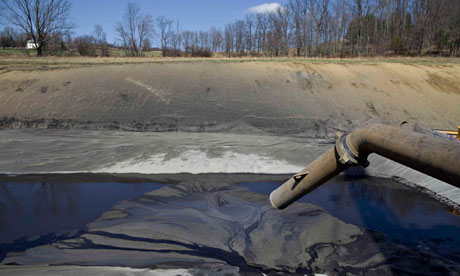Pennsylvania: the 'ground zero' of the US shale gas drilling boom
Sitting atop a vast deposit of natural gas, Pennsylvania knows how lucrative – and dangerous – this rapidly expanding industry is. But how can it prevent large-scale environmental damage?
• Fossil fuel firms use 'biased' study in massive gas lobbying push
• Fossil fuel firms use 'biased' study in massive gas lobbying push

A pipe leads to a lined pit used to collect drill cuttings near Montrose, Pennsylvania. Photograph: Daniel Acker/Getty Images
Last June, Tony Zaffuto arrived at his fieldstone cabin in the forested hills of Pennsylvania's SB Elliott state park to find a notice pinned on the front door: "Danger. Do not occupy dwelling".
A blowout at a gas well in another popular camping spot, in the woods of the Punxsutawney hunt club, also in Clearfield County, had shot a 23-metre (75ft) combustible gusher of gas and toxic waste water into the air. It took the gas company, EOG Resources, 16 hours to control the well and the authorities had to carry out an evacuation.
It was not Zaffuto's first encounter with the dangers of natural gas drilling. In 2009 the spring that was the cabin's only source of water was contaminated by toxic waste from a pond serving the gas wells. Five other nearby water wells were also contaminated.
And yet Zaffuto is right behind Pennsylvania's natural gas boom. He supports the idea of US energy security and he wants his country to reduce oil imports.
"Throughout all this, I am pro-drilling, but I want to see it done correctly," Zaffuto, a businessman whose family have owned the cabin since 1921, said. "Having it done correctly will not cripple the industry. If there is money to be made they will comply. If there is enough natural resource of gas in the ground, they will drill and they will abide by the regulations. It's simple."
But how can rigorous new environmental standards be imposed on an industry well advanced in the 21st century's first big energy rush?
Zaffuto still has no drinking water at his cabin, nearly two years after EOG admitted contaminating his well. The latest laboratory report says it is still unfit to drink.
The federal government is only now beginning to undertake a review of the chemicals that are used in hydraulic fracturing, or "fracking", the relatively recent technique used to release vast stores of natural gas buried underground.
The technique uses millions of litres of water, sand and a battery of chemicals – including carcinogens such as benzene – injected at high pressure to fracture the rock and release the stored gas.
A new report released by Democratic members of Congress on Monday found that drilling companies at times injected chemicals that even they could not identify. It also found that more than 650 of the chemicals used in fracking were carcinogens.
Environmental groups, and an investigation by the ProPublica investigative journalism website, have exposed several persistent dangers: leaks in wells owing to faulty casing or migration through layers or rock; breaches in the above-ground tanks meant to store used drilling chemicals; and a rise in air emissions.
Meanwhile, a report due to be published in the Climate Change journal this month from a team at Cornell University, in New York, challenged one of the fuel's main selling points – that shale gas is a low-carbon fuel. The study found that the carbon footprint for shale gas was far greater than conventional oil or gas or even coal – especially over the next 20 years, a crucial window for fighting climate change.
But the demands for greater regulation face powerful opposition from the natural gas companies, and it may be too late to reform an industry that is expanding at such a rapid rate.
Pennsylvania sits atop one of the world's largest deposits of natural gas, a formation known as the Marcellus shale, and the past five years have seen a takeoff in the natural gas industry.
Last year alone, oil and gas companies, such as Shell, Chevron, Reliance and BG Group (the Reading-based company that is one half of the former British Gas) poured $17.9bn (£10.8bn) into projects in the area last year. They drilled 1,415 new wells in Pennsylvania alone.
The companies expect to drill 2,000 additional wells this year, rising to 3,500 a year by the middle of the decade, said Katie Klaber, president of the Marcellus Shale Association, an industry group.
Some projections suggest there could be 100,000 new gas wells drilled in Pennsylvania by the end of this decade.
"There are very few counties that don't have at least a couple of Marcellus wells that have been drilled," she said. "Just about every county has some drilling." And, environmentalists argue, just about every county has direct experience of its dangers.
In the northern town of Bradford, entire streets have been outfitted with gas meters as precautions against methane gas migration. Two homes have exploded since late last year. "It was just a ball of fire that hit me in the face and caught my hair on fire," said Beverly Butler, whose house blew up on a Sunday afternoon before Christmas.
A number of towns have had to warn locals to boil tap water before drinking after water treatment plants were compromised by bromides in waste water from gas-drilling projects.
Thomas Au, a former lawyer with Pennsylvania's department of environmental protection, argues that the state was caught off guard by the rapid expansion of shale gas drilling.
The laws on the books were drawn up in an area of shallow wells – which in Pennsylvania's case dates back to the mid-19th century – and the regulators were not equipped to deal with the technological advances of hydraulic fracturing or with the increased activity.
J Stephen Cleghorn, who moved to his 50-acre (20-hectare) plot of land near the town of Reynoldsville six years ago to run an organic goat farm, is beginning to get the picture. Across his wooden kitchen table, he slides a survey map showing his goat farm surrounded by yellow-shaded blocs.
The map represents gas leases already acquired by EXCO Resources, a Texas-based firm which reached an agreement with BG Group last year to develop shale gas in Pennsylvania and West Virginia. Sometime over the last few months, the land directly beneath Cleghorn's 120-year-old farmhouse – which is under separate ownership – was also leased for drilling.
His immediate concern was the fate of his goats and the future of a business that depends on a promise of purity. But then Cleghorn said he realised that the potential damage went much farther. "I now realise that what they are talking about is a 22,000 square mile gas field across Pennsylvania that will affect all of our rivers, and all of our wells."
Environmentalists are divided about how to deal with that rapid expansion. Some in Pennsylvania are still hoping to bring the industry to a halt. Others though argue that the best hope is for better regulation.
"There is no plausible future in which gas drilling is banned in Pennsylvania. It is not going to happen. It is too lucrative and we have had a history of extraction in this state," said Jan Jarrett, president of the environmental group PennFuture. But that is all the more reason why the state needs to toughen up its standard of environmental protection.
"This is ground zero," she said. "If regulators don't adopt a zero tolerance for violations of standards then what we will have are places that are going to have unacceptable environmental damage."

No comments:
Post a Comment